Discovery: Depositions
A deposition is the taking of a statement of a witness or party under oath. The deposing party (the “asking” person) may ask the deponent (the “responding” person) questions to obtain information, to discover what the party knows about a situation or event, and to determine what their testimony would be at trial. Although depositions may be written or oral, this guide will only discuss the taking of oral depositions.
Templates and Forms
- Notice of Taking Deposition Template – RTF
- Deposition Subpoena for Personal Appearance (SUBP-015)
- Deposition Subpoena for Personal Appearance and Production of Documents and Things (SUBP-020)
Introduction
Each party may conduct one deposition of each other party. This limit is imposed to prevent parties from using the deposition process as a tool of harassment, and to make each party effectively use their deposition. Parties may also conduct depositions of any relevant witnesses in the case. A party may only conduct one deposition of any individual, though.
Taking an oral deposition is very expensive and time-consuming. The party requesting a deposition is responsible for paying all costs and fees related to the deposition. With hiring a court reporter, transcribing the reporter’s stenography, paying witness fees and travel expenses, etc., a short deposition can cost several hundred dollars or more! Because of this, many litigants prefer to use other discovery methods to obtain information and evidence. A very good discussion comparing depositions to other discovery methods is found in Chapter 1 of Dunne on Depositions in California, KFC 1020 .Z9 D86. Chapter 2 of that book provides tips for minimizing the costs of depositions.
Although depositions are expensive, they can be a very effective discovery tool. In many cases, the benefits can far outweigh the costs. Depositions are extremely useful for:
- Recording a party or witness’s story before trial so you may be better prepared for cross-examination at trial.
- Evaluating the credibility of a potential witness, or observing the impression they would make on the jury.
- Preserving testimony from a witness you suspect will be unfriendly or unavailable by the date of trial. Testimony given in a deposition may be used to impeach contradictory testimony given at trial.
- Obtaining additional information about physical evidence you’ve already obtained by other discovery methods, or laying the foundation for admissibility of physical evidence at trial.
- Obtaining testimony and physical evidence from a non-party witness.
Step by Step Instructions
1
Determine the Date and Location of the Deposition
California law provides very strict guidelines for the timing and location of depositions. When scheduling a deposition, you must select a date that allows for adequate notice to the deponent and other parties. In most types of cases, for the deposition of a party to the case, you must provide at least 10 days’ notice if personally served, and 15 days’ notice if served by mail within California (California Code of Civil Procedure (CCP) § 2025.270(a), § 1013). Additional time is required if service will be outside of California.
For the deposition of a non-party witness, CCP § 2020.220(a) only requires service of a subpoena in “sufficient time” to allow the witness to travel to the deposition location, and locate any documents or items requested. The law provides no definition of “sufficient time,” so unless there is considerable travel or an unusually large list of requested documents or items, it is usually reasonable to give the same notice you would give a party.
CCP § 2025.250(a) also provides specific guidelines for the location of a deposition. When a natural person is being deposed, whether or not that person is a party to the case, you must conduct the deposition either a) within 75 miles of the deponent’s residence, or b) within 150 miles of the deponent’s residence and in the forum county.
If your case is in Sacramento County, this means that you can hold your deposition in Sacramento County, as long as the deponent doesn’t have to travel more than 150 miles from his residence to the deposition location. If Sacramento County is more than a 150 mile trip, you will need to hold your deposition elsewhere, at a location no more than 75 miles from the deponent’s residence.
If you will be conducting a deposition of an organization that is a party to the case, the same rules apply, but distances are calculated from the organization’s principal executive or business office. If the deponent is a non-party organization, you must take the deposition within 75 miles of the organization’s principal executive or business office. Additional rules apply for depositions of experts and out-of-state residents.
2
Complete the Proper Forms
If deposing a party:
If you wish to take the deposition of a party to the case, you will need to prepare a notice of taking of deposition. There is no fill-in-the-blanks form for this; you will need to write your own notice. A sample is at the end of this Guide. You may download a customizable template from this link:
Your notice must include the name of the deponent, as well as the date, time, and location of the deposition. If the deponent is an organization, describe what matters you will be discussing, so that the organization may appoint a representative with the most knowledge of those issues. Describe any documents or other physical evidence you want the witness to bring to the deposition.
In your notice, you must also indicate if you plan to audio or video record the testimony, and if you reserve the right to present the recording at trial. If your court reporter will be providing instant visual display stenography, often referred to as “realtime deposition reporting,” you must include notice of that, as well.
If deposing a non-party witness:
If you wish to take the deposition of a non-party witness, you will need to subpoena the witness. The form you will need to use depends on if you want the witness to bring documents or things with them to the deposition.
- Deposition Subpoena for Personal Appearance (SUBP-015). Use this form if you simply want a witness to appear to answer questions at a deposition. Instructions for completing this form are available at the end of this Guide.
- Deposition Subpoena for Personal Appearance and Production of Documents and Things (SUBP-020). Use this form if you want a witness to appear to answer questions at a deposition, and to bring with them any documents or things. Instructions for completing this form are available at the end of this Guide.
After completing the subpoena form, make a photocopy. Take the original and the photocopy to the court to have the subpoena “issued” (stamped) by the clerk.
You will also need to prepare a notice of taking of deposition to serve on all parties in the case, notifying them of the date, time, and location where you will conduct the deposition of the non-party witness. There is no fill-in-the-blanks form for this; you will need to write your own notice. A sample is at the end of this Guide. You may download a customizable template from this link:
3
Make Copies
If deposing a party:
Make one photocopy of your notice of taking of deposition for each party in the case.
If deposing a non-party witnesses
Make one photocopy of the issued subpoena for the deponent and one for each party in the case. Make one photocopy of the notice of taking of deposition for each party in the case
4
Serve Your Documents
If deposing a party:
A photocopy of the notice of taking of deposition must be served on the attorney for the deponent or directly to the deponent if he or she is self-represented (in pro per). Copies must also be served on all other attorneys or self-represented parties who have appeared in the case, as all attorneys and self-represented parties are entitled to attend the deposition and question the deponent. CCP § 2025.240. Service may be completed by mail, by a person over the age of 18 who is not a party to the case. The person serving your requests must complete a Proof of Service by First Class Mail (POS-030). For more information, see the Step-by-Step guide on Proof of Service by Mail.
If deposing a non-party witness
A photocopy of the subpoena (SUBP-015 or SUBP-020) must be personally served on the deponent. The person performing this personal service will complete the Proof of Service on the second page of the subpoena form. For more information, see the Step-by-Step guide on Personal Service of Court Papers.
A photocopy of both the subpoena and the notice of taking of deposition must be served all attorneys or self-represented parties in the case (CCP § 2025.240). Service may be completed by mail, by a person over the age of 18 who is not a party to the case. The person serving your documents must complete a Proof of Service by First Class Mail (POS-030). For more information, see the Step-by-Step guide on Proof of Service by Mail.
If the non-party witness is a public employee of certain law enforcement-related agencies or the court, and their deposition relates to information gathered in the course of their job duties, service may be completed by personally serving the witness OR by serving two copies of the subpoena to the employee’s immediate supervisor or to an agent designated for service. California Government Code (Govt Code) § 68097.1. See Step 5 below for more information about subpoenaing public employees.
Retain your original issued subpoena and notice of taking of deposition for your records. These original documents may be submitted to the court in the event that the subpoenaed party doesn’t show up and an order or warrant is required.
5
Pay Witness Fees
Non-party witnesses are entitled to witness fees, which are $35 per day, plus $0.20 per mile actually traveled to and from the place of deposition. Govt Code § 68093. Expert witnesses are also entitled to witness fees, in the amount of their normal hourly rate for the time they are in the deposition. CCP § 2034.430(b). These fees may be paid at the time the subpoena is served, or at the beginning of the deposition. Many litigants wait to pay these fees until the witness appears at the deposition.
If a non-party witness is a public employee, you must reimburse the employing agency the full cost incurred by the agency for the employee’s salary and travel expenses for each day the employee is required to attend the deposition. Govt Code § 68096.1 et seq. At the time the subpoena is served, you must give the employing agency $275 per day for each day you will require the employee to attend the deposition. This serves as a deposit toward those fees. If the actual costs are less, you will be reimbursed. If the actual costs are higher, you will have to provide additional funds to the agency.
Party deponents are not entitled to witness’s fees or mileage.
6
Conduct the Deposition
Be sure you come prepared to the deposition. It is a good idea to have an outline of your questions or the issues you wish to cover, to ensure you obtain all the information you’ll need. You will have to ask all your questions now, because you can only conduct one deposition of any person during your case. You will also want to do some research ahead of time, to prepare yourself to handle problems such as objections to your questions, non-responsive answers, or hostile witnesses. The resources listed at the end of this Guide are good starting points for this type of research.
At the beginning of the deposition, the court reporter will swear in the deponent. Then, everyone in attendance should announce their names, firm names, and who they represent for the record. You may then provide any admonitions or instructions you have for the deponent before moving on to your questions. For more tips and techniques for conducting the deposition, consult the resources listed at the end of this Guide.
7
After the Deposition
Unless the parties agree otherwise, the court reporter is required to make a transcript of the deposition, and provide written notice to the deponent and all parties attending the deposition when the transcript is ready for reading, correcting, and signing. After this notice is sent, the deponent has 30 days to change the form or substance of the answer to any question, and to approve the transcript by signing it. Changes will be noted directly on the original copy of the transcript.
The reporter will certify that the deponent was duly sworn, and that the transcript is a true record of the testimony given and any changes made by the deponent. The original certified copy of the transcript will then be forwarded to the deposing party, who must retain this original in a safe place where it is protected from loss, destruction or tampering until at least six months after the final disposition of the case. CCP § 2025.550.
For More Information
At the Law Library:
About Your Deposition (DVD) KF 8900 .V56 (Self-Help Audio-Video)
California Civil Discovery KFC 1020 .H64
Electronic Access: On the Law Library’s computers, using Lexis Advance.
California Civil Discovery Practice KFC 1020 .C35
Electronic Access: On the Law Library’s computers, using OnLaw.
California Civil Litigation and Discovery KFC 995 .G674
California Deposition and Discovery Practice KFC 1020 .D44
Electronic Access: On the Law Library’s computers, using Lexis Advance.
California Discovery Citations KFC 1020 .F56
California Forms of Pleading and Practice KFC 1010 .A65 C3 (Ready Reference)
Electronic Access: On the Law Library’s computers, using Lexis Advance.
California Practice Guide: Civil Procedure Before Trial KFC 995 .W45
Deposition Checklists and Strategies KF 8900 .S33
Dunne on Depositions in California KFC 1020 .Z9 D86
Effective Depositions KF 8900 .E35
Handling Depositions: Here’s How and When to Do it KFC 1020 .D47 R35
Electronic Access: On the Law Library’s computers, using OnLaw.
Nolo’s Deposition Handbook KF 8900 .B44 (Self-Help)
Electronic Access: From any computer (Library or home) via the Legal Information Reference Center. Instructions are available on our website at Download E-Books.
Preparing for Your Deposition (DVD) KF 8900 .A76 A27 (Self-Help Audio-Video)
Samples
Notice of Taking Deposition
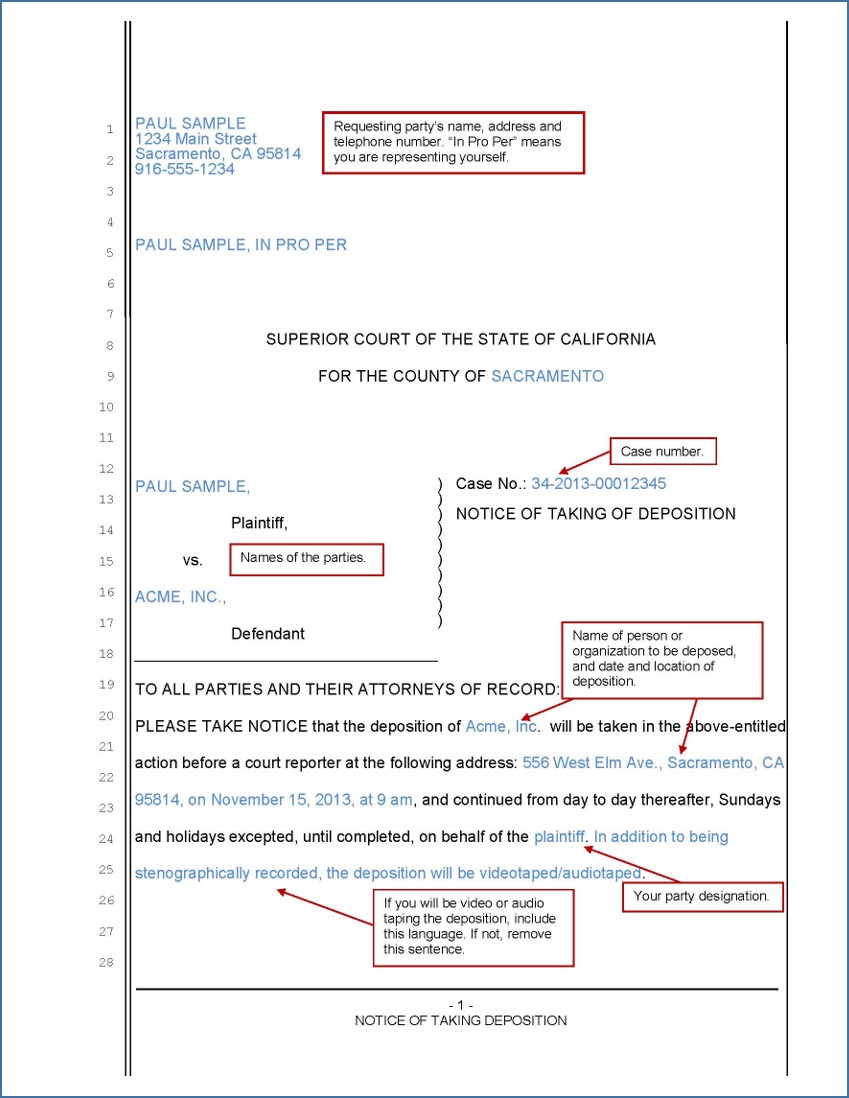
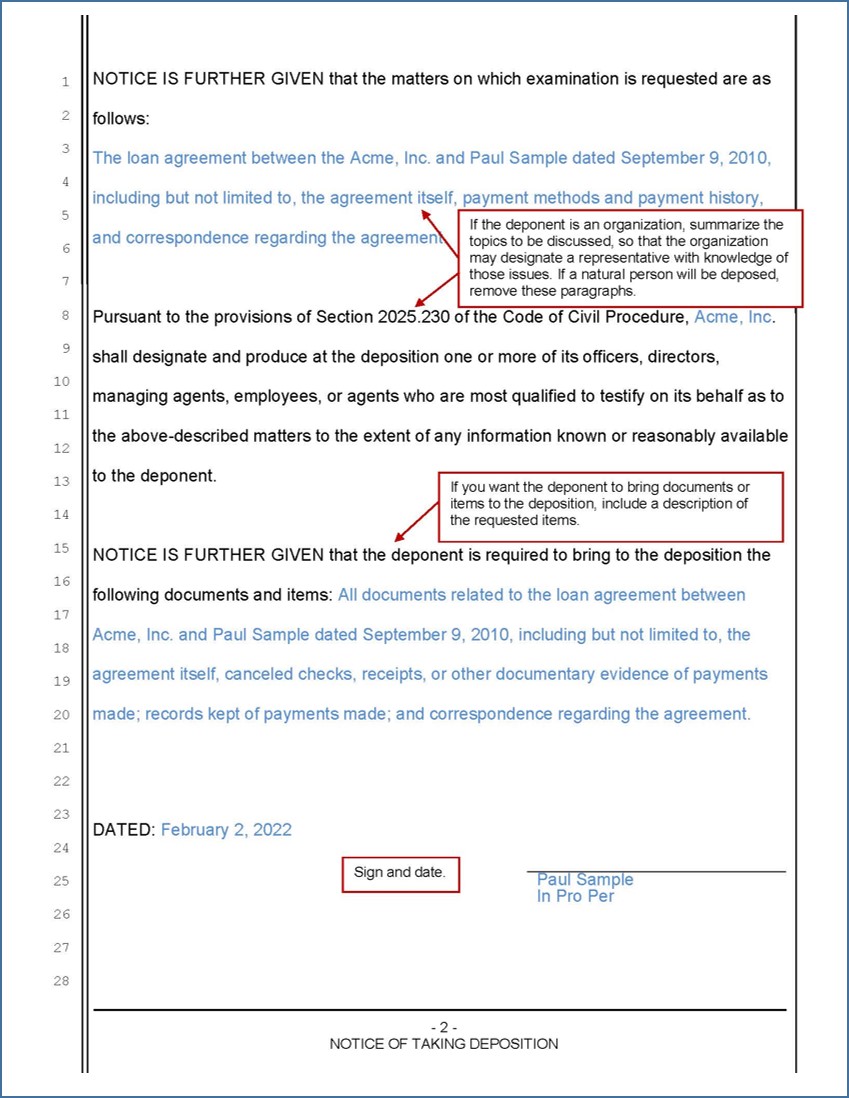
Deposition Subpoena for Personal Appearance
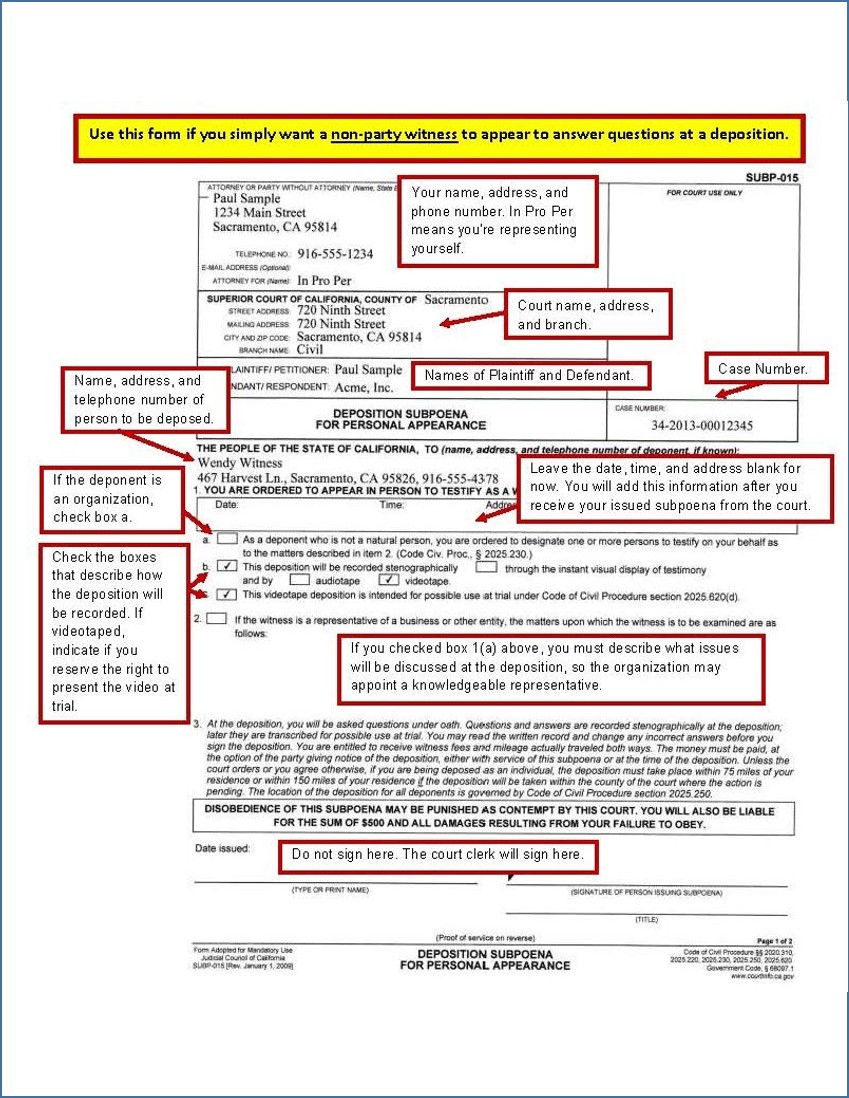
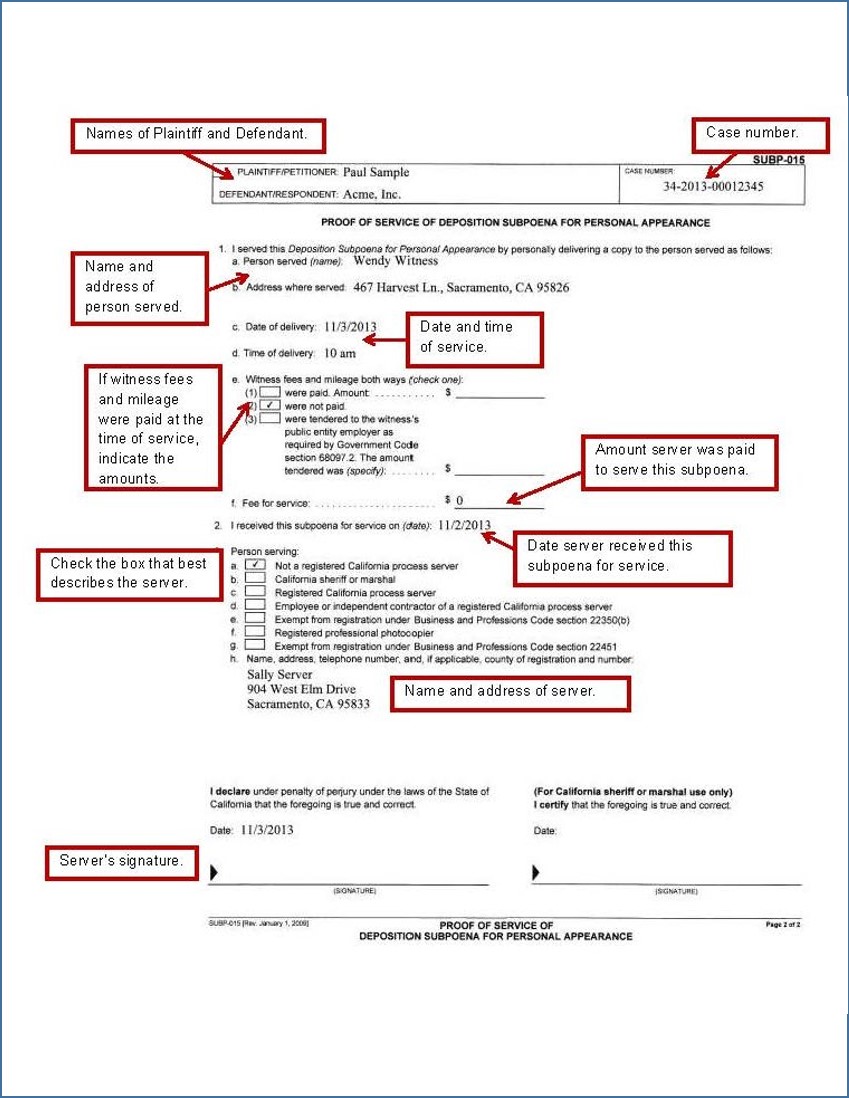
Deposition Subpoena for Personal Appearance and Production of Documents and Things
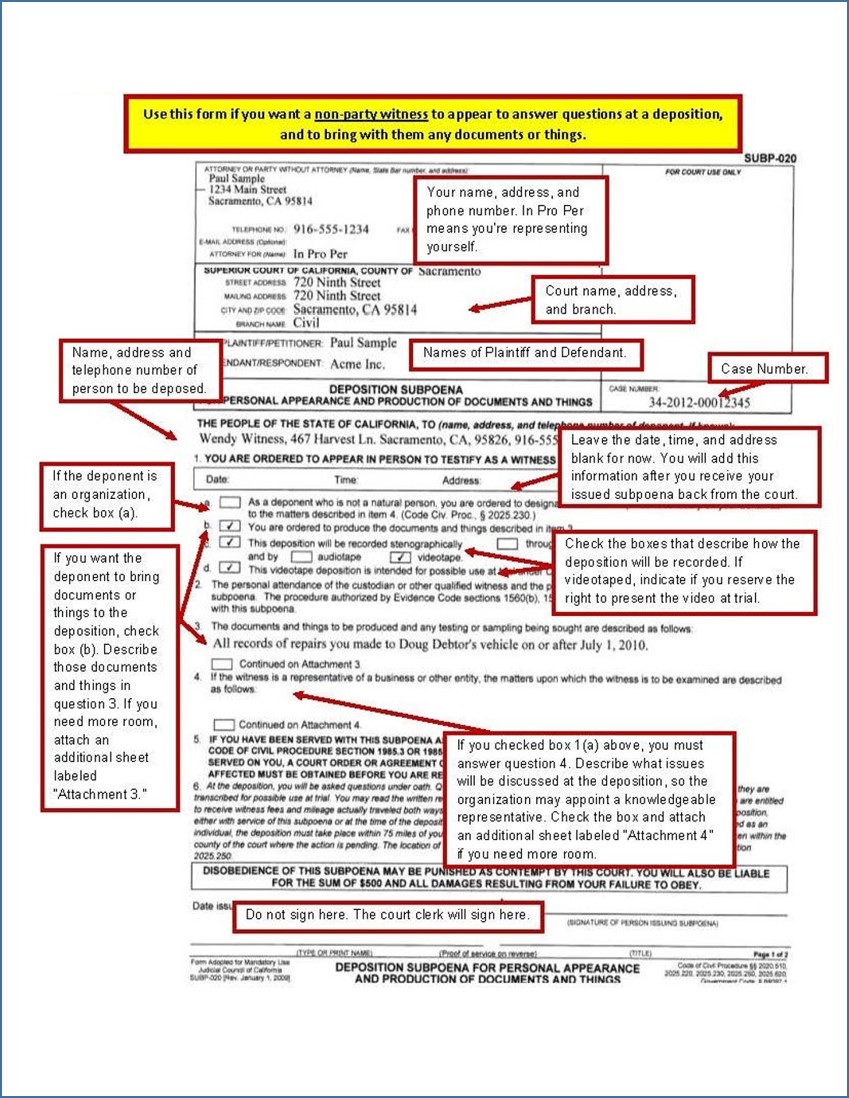
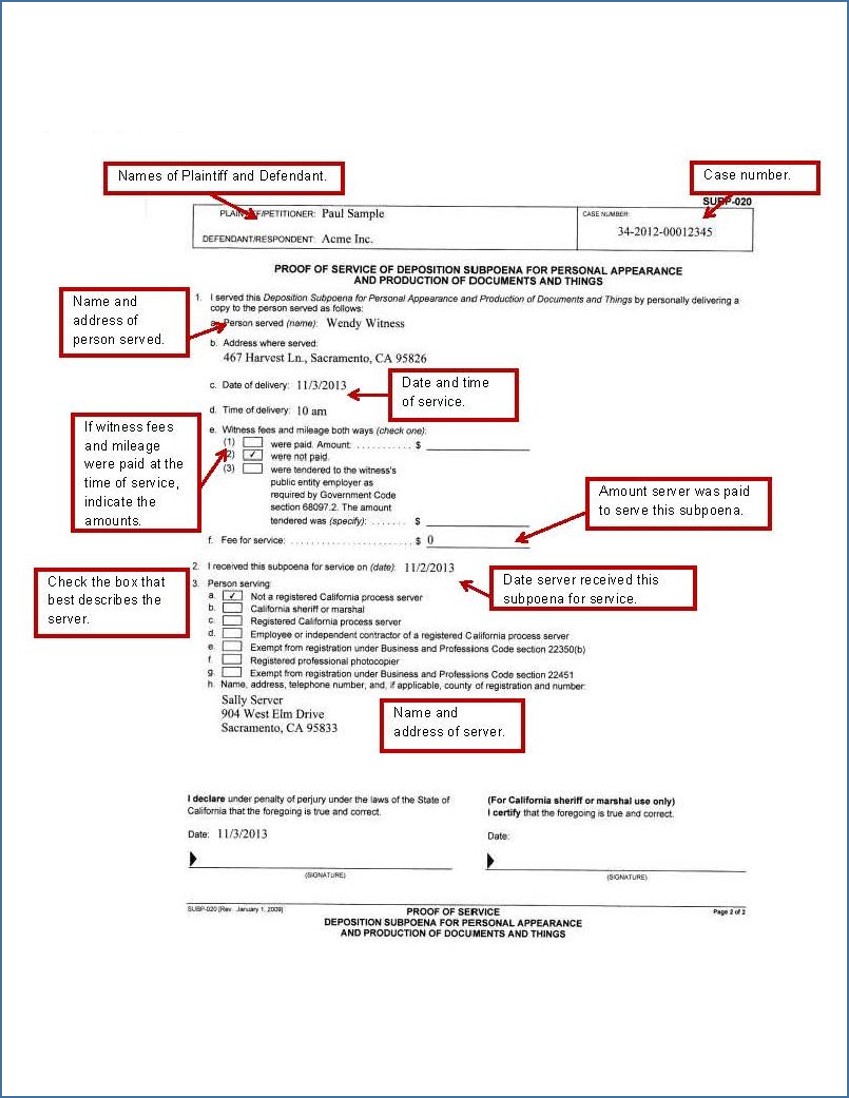
This material is intended as general information only. Your case may have factors requiring different procedures or forms. The information and instructions are provided for use in the Sacramento County Superior Court. Please keep in mind that each court may have different requirements. If you need further assistance consult a lawyer.




